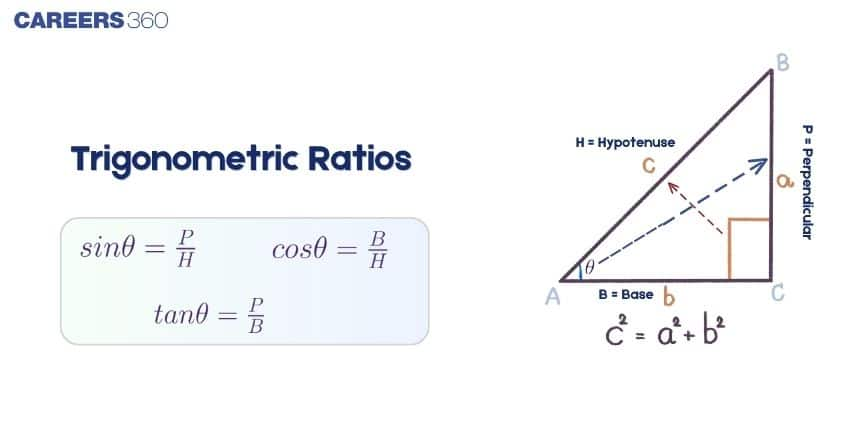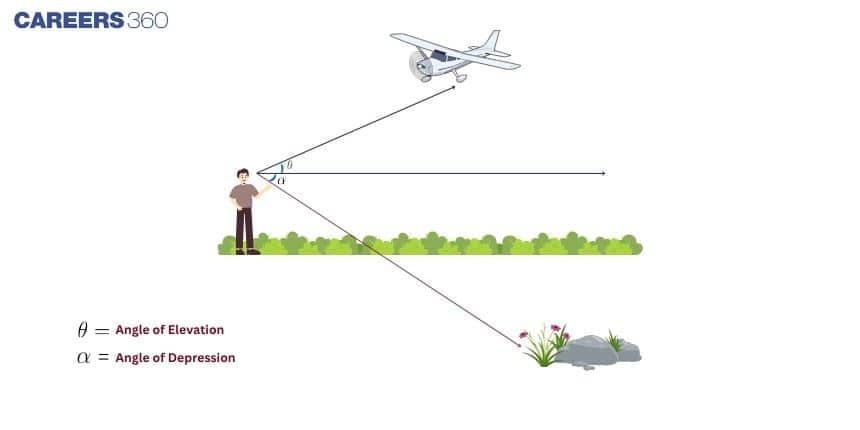Trigonometry
Imagine you are standing at the bottom of a tall tree and want to know its height without climbing it. You can measure the distance from the tree and the angle of elevation from your eyes to the top of the tree. This is where trigonometry comes in handy. Trigonometry is the branch of mathematics that studies the relationship between the angles and sides of right-angled triangles. Using simple ratios like sine, cosine, and tangent, we can calculate heights, distances, and angles in real-life situations, making math practical and fun. In this article, we will explore the basic concepts, important formulas, and NCERT Resources for trigonometry to help Class 10 students understand and apply these concepts effectively.

What do you mean by Trigonometry?
Trigonometry is a branch of mathematics that deals with the relationship between the angles and sides of a triangle, especially a right-angled triangle. The word Trigonometry comes from two Greek words: "trigonon" meaning triangle and "metron" meaning measurement. So, trigonometry simply means “measurement of triangles.”
In real life, trigonometry is used more than you might think. From measuring the height of a tree without climbing it to calculating the distance of a ship from the shore, trigonometry helps us solve problems that involve heights, distances, slopes, and angles.
The main role of trigonometry is to connect angles with ratios of sides. For example, in a right-angled triangle, if one angle and one side are known, trigonometry helps us find the remaining sides easily. It uses six special ratios called trigonometric ratios:
$ \sin \theta $
$ \cos \theta $
$ \tan \theta $
$ \csc \theta $
$ \sec \theta $
$ \cot \theta $
These ratios are based on the sides of a right-angled triangle.
Basics of Right-Angled Triangles
Right-angled triangles are the foundation of Class 10 trigonometry. A right triangle is a triangle that has one angle equal to $90^\circ$. Trigonometry uses such triangles to define trigonometric ratios based on the sides and angles.
Parts of a Right-Angled Triangle
A right-angled triangle has:
One $90^\circ$ angle
A longest side called the hypotenuse
The other two sides called legs
These are defined as:
Hypotenuse – side opposite the right angle
Opposite side – side opposite the angle $\theta$
Adjacent side – side next to the angle $\theta$
These names depend on which angle $\theta$ we are considering.

Angles and Sides: Hypotenuse, Opposite, Adjacent
For any right triangle:
Hypotenuse is always fixed as the longest side.
The adjacent and opposite sides change based on the chosen reference angle $\theta$.
Correct side identification is important to apply trigonometric ratios correctly in height and distance problems.
Trigonometric Ratios and Functions
Trigonometric ratios establish a relationship between the angles and sides of a right-angled triangle. These are used to find heights, distances, and angles in real-world problems.
Sine, Cosine, and Tangent Explained
The three primary trigonometric ratios are:
$ \sin \theta = \dfrac{\text{Opposite}}{\text{Hypotenuse}} $
$ \cos \theta = \dfrac{\text{Adjacent}}{\text{Hypotenuse}} $
$ \tan \theta = \dfrac{\text{Opposite}}{\text{Adjacent}} $
These ratios help calculate missing sides or angles of a triangle when one angle (other than $90^\circ$) and one side are known.
Reciprocal Functions: Cosecant, Secant, Cotangent
Each primary ratio has a reciprocal:
$ \csc \theta = \dfrac{1}{\sin \theta} = \dfrac{\text{Hypotenuse}}{\text{Opposite}} $
$ \sec \theta = \dfrac{1}{\cos \theta} = \dfrac{\text{Hypotenuse}}{\text{Adjacent}} $
$ \cot \theta = \dfrac{1}{\tan \theta} = \dfrac{\text{Adjacent}}{\text{Opposite}} $
These are also part of the Class 10 trigonometry formula list and are used in simplification.
Relationship Between Trigonometric Ratios
Important trigonometric relationships include:
$ \tan \theta = \dfrac{\sin \theta}{\cos \theta} $
$ \cot \theta = \dfrac{1}{\tan \theta} = \dfrac{\cos \theta}{\sin \theta} $
$ \sec \theta = \dfrac{1}{\cos \theta}, \quad \csc \theta = \dfrac{1}{\sin \theta} $
These help simplify trigonometric functions and solve problems faster.

Important Trigonometric Identities for Class 10
Trigonometric identities are formulas that hold true for all angles. These are very important for board exams and problem-solving.
Pythagorean Identity
The most fundamental identity is:
$ \sin^2 \theta + \cos^2 \theta = 1 $
Derived from this are:
$ 1 + \tan^2 \theta = \sec^2 \theta $
$ 1 + \cot^2 \theta = \csc^2 \theta $
Complementary Angle Identities
If two angles add up to $90^\circ$, they are complementary. Identities are:
$ \sin(90^\circ - \theta) = \cos \theta $
$ \cos(90^\circ - \theta) = \sin \theta $
$ \tan(90^\circ - \theta) = \cot \theta $
$ \cot(90^\circ - \theta) = \tan \theta $
$ \sec(90^\circ - \theta) = \csc \theta $
$ \csc(90^\circ - \theta) = \sec \theta $
These are useful for simplification and NCERT exercises.
Ratio and Quotient Identities
Some basic usable identities are:
$ \tan \theta = \dfrac{\sin \theta}{\cos \theta} $
$ \cot \theta = \dfrac{\cos \theta}{\sin \theta} $
These identities help when converting one trigonometric function into another.
Trigonometric Values at specified angles
Trigonometric Values help students quickly evaluate $ \sin \theta $, $ \cos \theta $, $ \tan \theta $ and their reciprocal ratios at standard angles like $0^\circ$, $30^\circ$, $45^\circ$, $60^\circ$, and $90^\circ$. These values are essential for solving Class 10 trigonometry problems in competitive exams.

Height and Distance – Applications of Trigonometry
Trigonometry is not just theory it has real-life uses. The concepts of height and distance help us find the height of buildings, towers, poles, and even the distance of ships or mountains without direct measurement. These problems are solved using trigonometric ratios like $ \sin \theta $, $ \cos \theta $, and $ \tan \theta $ in right-angled triangles.
Angle of Elevation and Angle of Depression
The angle of elevation is the angle formed when we look upward at an object from the horizontal line of sight. The angle of depression is formed when we look downward from a height. In both cases, we use right-angled triangles and apply ratios like $ \tan \theta = \frac{\text{opposite}}{\text{adjacent}} $ to find unknown heights or distances.
Real-Life Word Problems on Trigonometry
Height and distance problems are commonly used in engineering, navigation, architecture, and astronomy. For example:
- Finding the height of a tree using its shadow
- Finding how far a ship is from a lighthouse
- Calculating the height of a tower using angle of elevation
These real-life trigonometry problems make learning practical and fun.
Step-by-Step Problem Solving Strategy
To solve trigonometry word problems easily:
Read the question carefully and understand what is given.
Draw a neat right-angled triangle diagram.
Mark angles and lengths (known and unknown).
Identify the correct trigonometric ratio: $ \sin \theta $, $ \cos \theta $, or $ \tan \theta $.
Form an equation, solve step-by-step, and write the final answer with units.
Recommended books for Trigonometry
Choosing the right books is essential to build a clear understanding of trigonometric concepts like $ \sin \theta $, $ \cos \theta $, and $ \tan \theta $, especially at the Class 10 level. Below is a list of the most trusted and student-recommended books that explain trigonometry step by step and provide plenty of practice for exams.
| Book Title | Author/Publisher |
|---|---|
| NCERT Mathematics – Class 10 | NCERT |
| RS Aggarwal – Mathematics for Class 10 | S. Chand Publications |
| RD Sharma – Mathematics Class 10 | Dhanpat Rai Publications |
| All in One Mathematics Class 10 | Arihant Publications |
| Mathematics Exampler Problems – Class 10 | NCERT |
| Lakhmir Singh & Manjit Kaur Mathematics | S. Chand |
| Oswaal Question Bank Class 10 Maths | Oswaal Books |
| Together With Mathematics Class 10 | Rachna Sagar |
| Xam Idea Mathematics Class 10 | VK Global Publications |
| CBSE Chapterwise Solved Papers – Mathematics Class 10 | Arihant |
NCERT Resources for Chapter 8 - Introduction to Trigonometry
This section provides step-by-step explanations, exemplar solutions and notes that build a strong foundation for understanding trigonometric ratios and identities. These resources follow the CBSE curriculum and are essential for exam preparation and concept clarity.
NCERT Class 10 Maths Notes for Chapter 8 - Introduction to Trigonometry
NCERT Class 10 Maths Solutions for Chapter 8 - Introduction to Trigonometry
NCERT Class 10 Maths Exemplar Solutions for Chapter 8 - Introduction to Trigonometry
Frequently Asked Questions (FAQs)
Trigonometry is a branch of mathematics that studies the relationship between the angles and sides of triangles, especially right-angled triangles, using trigonometric ratios like $ \sin \theta $, $ \cos \theta $, and $ \tan \theta $. It is used in real-life problems such as calculating heights and distances.
The six main trigonometric ratios are:
$ \sin \theta = \frac{\text{opposite}}{\text{hypotenuse}} $
$ \cos \theta = \frac{\text{adjacent}}{\text{hypotenuse}} $
$ \tan \theta = \frac{\text{opposite}}{\text{adjacent}} $
$ \csc \theta = \frac{1}{\sin \theta} $
$ \sec \theta = \frac{1}{\cos \theta} $
$ \cot \theta = \frac{1}{\tan \theta} $
The angle of elevation is measured when you look upward from the horizontal line to an object. The angle of depression is measured when you look downward from a height to an object. Both are used in height and distance problems using trigonometry.
Important trigonometric identities include:
Pythagorean identity: $ \sin^2 \theta + \cos^2 \theta = 1 $
Quotient identities: $ \tan \theta = \frac{\sin \theta}{\cos \theta}, \quad \cot \theta = \frac{\cos \theta}{\sin \theta} $
Complementary angle identities: $ \sin(90^\circ - \theta) = \cos \theta $, $ \cos(90^\circ - \theta) = \sin \theta $
Trigonometry is used to measure heights and distances without physical measurement, in engineering, navigation, architecture, astronomy, and even in computer graphics. For example, calculating the height of a tower using its shadow or the distance of a ship from a lighthouse.